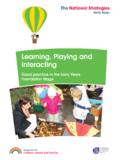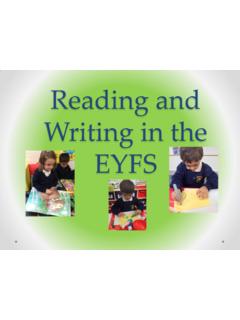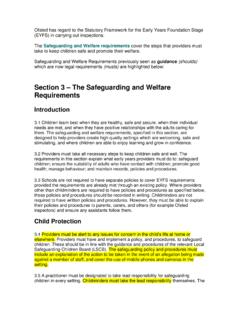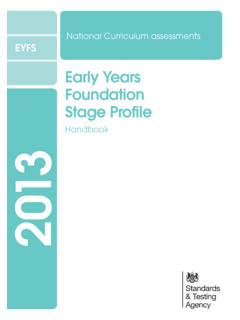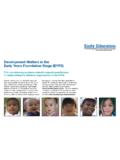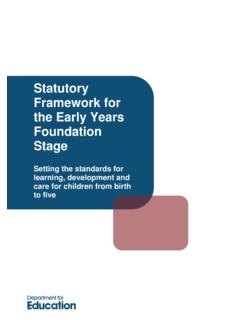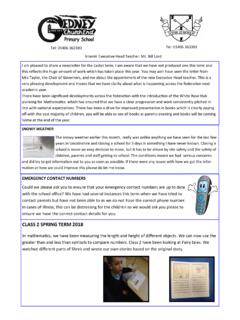Transcription of Key messages - KEAP
1 The early Years Foundation stage 00012-2007 CDO-ENEffective practice: parents as Partners Crown copyright 200701 Effective practice: parents as PartnersKey messagesParents provide a learning environment which is enduring and comprehensive. It begins even before birth, operates beyond the child s day at the setting and provides continuity as the child transfers from one setting to another. Over 70% of children s lives are spent, not in a setting, but with their family and the wider community. Therefore home and community must be recognised as significant learning environments in the lives of children. All parents can enhance their child s development and have the right to play a central role in making decisions about their child s care and education at every level.
2 Successful relationships between parents and educators can have long-lasting and beneficial effects on children s learning and well-being. Successful relationships become partnerships when there is two-way communication and parents and practitioners really listen to each other and value each other s views and support in achieving the best outcomes for each parents as Partners meansAll settings should develop effective partnerships with parents in order to enhance the learning and development of the children with whom they work. We are all learners from birth and it is usually our parents who first give us the confidence and motivation to explore the world around us and who continue to keep us learning and stretching the boundaries of our understanding.
3 parents are very interested in their children s progress from baby to child and beyond. early years practitioners are also interested in children s progress. parents and practitioners thus share a joint interest in, and responsibility for, children s development and learning. Both parents and practitioners are key people in building children s self-esteem and dispositions to learn, although they bring different perspectives and expertise. parents are experts on their own child, practitioners are experts on children s learning and development. Children usually feel more confident and positive about themselves and their learning when parents and practitioners work together in an atmosphere of mutual respect.
4 Effective practice in relation to parents as PartnersRespecting diversity We live in a diverse and changing society. Young children s attitudes towards diversity are affected by the behaviour of adults around them and by whether all children and families using the setting are valued and welcomed. Inclusive settings recognise and celebrate diversity. Sometimes practitioners assume that their own way of being a parent, a family member or relating to children is the only right way to do things, but effective parenting can take many different forms. The early Years Foundation stage 00012-2007 CDO-ENEffective practice: parents as Partners Crown copyright 200702 The first contact parents have with practitioners sets the tone for all future contact.
5 The smile that greets a parent as they walk through the door conveys a really important and simple message, You are welcome here ; the lack of a smile, however, can say, You are not welcome here .All parents will feel slightly apprehensive the first time they walk through your door. Some parents may find it relatively easy to find the door in the first place; others may feel more intimidated about taking the first steps to get to know about, and make contact with, a setting. Consider your admissions policy: if a setting operates on a purely first come, first served basis, parents who are unfamiliar or unable to cope with the procedures may feel excluded.
6 parents who do not easily access settings have sometimes been categorised as hard to reach . A more helpful way of thinking about this situation may be to see the setting as being hard to reach , rather than the parent. This then involves the setting itself taking responsibility for becoming more accessible to the whole community. The majority of early years practitioners are female. This, coupled with stereotypical views of childcare as women s work , often has the effect of making the setting feel like a no-go area for fathers. However, it is the responsibility of settings to challenge this and make fathers and other significant males in children s lives feel valued.
7 Some questions to consider: Do you actively seek to recruit male staff?Do you run any men-only sessions? Do you ask for volunteers to help with activities that might appeal more to fathers in your area than mothers? Do you avoid sexist language when talking with fathers?Do you share their children s achievements with them in the same way as you do with mothers? Do you value boys play (including superhero and weapon play) as highly as that of girls? The following case studies demonstrate some key features of effective practice around admission and accessibility. Case study 1 Barbara is a childminder who belongs to an accredited network linked to a children s centre.
8 She has lived in the area for many years and knows a lot of people. She puts local parents in touch with the children s centre because she is aware of the support it offers and feels part of it herself. She takes children there for sessions and has gone to the centre in the evening for her own continuing professional development. She is sensitive to the way in which parents may be very worried about leaving their children with her. She knows that often, although parents really want warm, loving, home-based care for their child, they are worried that they will grow to love Barbara more than them. She tactfully explains that children do not have a finite pool of love, that there is more than enough to go around and that parents are always special to their child.
9 If the child seems reluctant to go home it is not because they don t love the parent, but usually because they are enjoying what they are doing and don t want to stop immediately. She makes time to chat about what they have been doing and to share the progress the child has made in a friendly, informal way. Throughout the time children are with her she ensures that she talks about the children s learning and development with any other settings they attend, for example, the children s centre, and any other setting or school sessions during the day. This ensures continuity of learning for them and also means she can inform working parents about things they need to know about their children s day: their progress, development, learning and/or particular needs.
10 The early Years Foundation stage 00012-2007 CDO-ENEffective practice: parents as Partners Crown copyright 200703 Case study 2At the children s centre families come from a range of ethnic groups and cultural traditions. The centre employs practitioners from the local community, some of whom are bilingual. There is one member of staff who has particular responsibility for ensuring that families know about the services available and acts as a link between the families, key staff and other practitioners ensure that the displays and resources reflect children s home and community experience and they all know some words of greeting in the main community languages.

